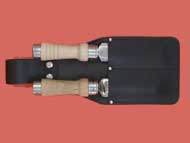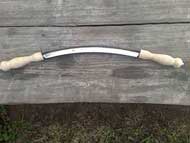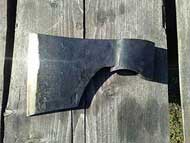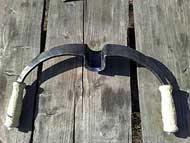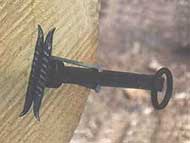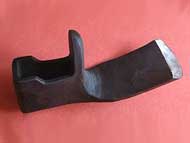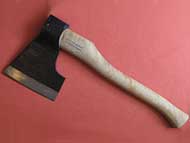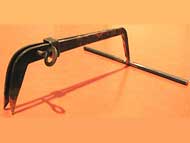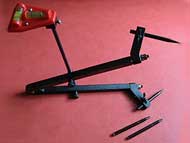Our Technology
Log House Construction Technology
Monivet builds log houses with the aid of several construction technologies, in particular the Canadian, Norwegian and the Russian hook technology. These technologies represent traditional methods used for log house construction that are enriched with the latest findings of research focusing on the properties and the preservation of wood.
This considerably increases the life span of wooden structures, while preserving their outstanding properties. Monivet focuses on the construction of log houses with the use of the Norwegian technology, the traditional Canadian technology, as well as the Russian hook technology. These technologies differ namely in the shape of the cross section of the main construction components. The Canadian technology uses round timber, while the Norwegian technology utilises surfaced logs known as prisms. The Russian hook technology uses round logs with hewn interior walls, which means that the surface of the interior walls is flat, while the exterior walls are formed by round logs. In addition to forming the bearing structure of the house, the beams and logs also effectively insulate its walls.
The trunks used for construction of a log house are handpicked in the forest with utmost care. As a rule, fully-grown trees approaching the end of their vegetative life are chosen as construction material. The wood is repeatedly sorted during handling to ensure that only healthy trunks with a diameter ranging from 280 to 500 mm are further processed. Trunks with an incorrectly twisted grain, of poor quality or visibly damaged are discarded. Subsequently, bark is manually removed from the sorted logs. If the bark is peeled off manually, the wood retains its natural beauty. Fresh and naturally moist trunks are used for the construction of a log house. The trunks are further processed and treated depending on the chosen technology.
Norwegian Technology
It is characterised by the use of logs known as prisms that are processed on two sides. The surface of the interior and exterior walls of a log house built with the aid of the Norwegian technology is always flat. A typical feature of this technology is the "Norwegian joint", i.e. a wedge that is cut into the log manually with an axe (i.e. "axe technology"). This joint is unique in the way in which it allows the logs to interlock in the corners (i.e. wedge to wedge) as a result of their own weight while the house is settling and drying (even in the case of pre-dried timber). This eliminates possible deformation and unwanted rotation of the components due to intense internal tension. In order to prevent the prisms in the walls from swaying and to avoid any unevenness in the house walls, the prisms are vertically interconnected with wooden pins. Holes are drilled into the wall beams into which pins are inserted to connect the adjacent beams together. The pins are made of the same type of wood as the house. This construction technology requires a technological interruption after the assembly of house is completed to allow the structure to settle down and the wood to dry. In case of the Norwegian technology, such an interruption may last from 7 to 8 months depending on the size and the complexity of the structure. Afterwards, the dimensions of all openings are precisely measured in order to make tailor-made windows and doors.
Technology Characteristics:
Canadian Technology
This technology is characterized by the use of round timbers as the main construction component. The trunks may be processed into construction components as soon as bark is removed. This construction method requires immense craftsmanship and precise workmanship. The typical feature of this technology is that there are no spaces between logs thanks to which the walls appear as though made of one solid block. The absence of gaps between the logs is achieved with the aid of a special marker. In this case, insulation is placed in an insulation groove leading along the whole length of the log. Since the logs retain their natural curved shape, they provide the house and its walls with a one of a kind appearance and character. The precisely (with an accuracy of one millimetre) tooled corner log joints are a perfect example of true carpentry artistry. Another unique feature of this technology is that the outer layer of the round timbers remains intact (it is removed only during timbering). This prevents the walls from freezing when temperatures drop below zero and substantially prolongs the life of the structure. The preserved outer layer contributes to the proper filtration of air in the round timber and creates a unique microclimate inside the log house, keeping the interior cold in summer and warm in winter. Moreover, the preservation of the solid outer layer (a 3-5 cm layer) makes the round timber more resistant to the effects of the surrounding environment, to mould occurrence, blueing, as well as to structural changes caused by UV radiation.
Technology Characteristics:
Wood Protection
In order to protect the individual logs, prisms and other log house components, we use natural oils and waxes, which preserve the natural appearance of wood and enhance its weatherproof properties. Pigmented glazes by Kreidezeit, which are available in a wide range of colours and shades, add a special touch to the final look of the wood, as well as the individual components. The priming (ground) coat is applied when the log house is disassembled while still at the plant. The first coat protects the individual house components during transport. It is only temporary as it vaporizes after 2 months and a new coat providing long-term protection needs to be applied. The most suitable are natural oils and waxes because they provide wood with the necessary protection. These products offer comprehensive care for the interior and exterior of the log house. As regards insulation material in the houses built by us, clients may choose products from the ISOLENA company, which manufactures thermal insulation with the use of sheep wool. Sheep wool may replace all thermal insulation materials used throughout the house. Its thermal and insulation properties match other traditional insulation materials. As a genuinely natural material, sheep wool is becoming widely used in the construction of wooden houses. Thanks to its unique protein fibre structure, sheep wool creates a more pleasant environment inside the house. And since it does not contain any artificial or cellulose fibres, there is no risk of any dust or small particles being released into the air (as in the case of glass silk). Sheep wool insulation does not increase the volume of dust in the house either during installation or subsequent use. Prior to use, wool is treated with chemicals that enhance its resistance to pests and moisture. Naturally, wool is anti allergic and helps regulate the level of humidity in the interior. We recommend ISOLENA for the insulation of our wooden houses because it is an environmentally-friendly and very pleasant material.
Wood is highly aesthetic, elegant and above all ecological. It is the healthiest and the most natural material for man.
Russian Hook Technology
This technology is characterized by the use of components that are naturally round on the outside and in the corners and flat on the inside. It is an old technique developed by carpenters from the Sokol district of the Nizhny Novgorod Region, which is well known for its tradition of manual building of log houses and wooden ships. The Russian hook technology is a technique of hooking overhanging logs together in the corner. It is a more complex method as it uses round logs with a basic plug and hewn interior walls. It is rather demanding and requires a high level of carpentry craftsmanship. The planed walls require no additional processing, which results in considerable cost savings. The Russian hook technology offers the most reliable joining of logs in the corners. A house built with the aid of this technology retains the matchless beauty of round timber while offering considerable interior comfort.
Technology Characteristics:
Larch
As the hardest European coniferous trees with a life span of up to 20 years, the Krasnoyarsk larch undoubtedly belongs among very attractive, yet still not "Oriental" woody species (Figure 3).
Green Roof Technology
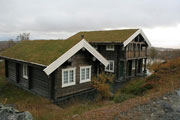 Green roofs have been known throughout the world for ages, especially in northern countries. In certain areas, they are widely used even today, often in combination with log cabins. A green roof is in fact a continual layer of soil with vegetation, which is placed on a specific base layer. The base layer separates the soil from the structure and protects it against penetrating roots and moisture. Compared to traditional roofing material, the green roof technology offers a number of advantages.
Green roofs have been known throughout the world for ages, especially in northern countries. In certain areas, they are widely used even today, often in combination with log cabins. A green roof is in fact a continual layer of soil with vegetation, which is placed on a specific base layer. The base layer separates the soil from the structure and protects it against penetrating roots and moisture. Compared to traditional roofing material, the green roof technology offers a number of advantages.
The most significant advantages include:
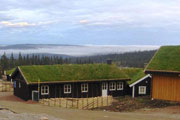 Green roofs are divided into two categories: extensive and intensive. Intensive green roofs offer the possibility of being used as an additional, grass-covered part of the garden. An intensive green roof is designed to accommodate people who may sunbathe or relax on it all day. Extensive roofs, on the other hand, are not designed to be walked on.
Green roofs are divided into two categories: extensive and intensive. Intensive green roofs offer the possibility of being used as an additional, grass-covered part of the garden. An intensive green roof is designed to accommodate people who may sunbathe or relax on it all day. Extensive roofs, on the other hand, are not designed to be walked on.
Parameters
Intensive green roofs are fitted with safety railing. The inclination of green roofs ranges from 5 to 45° or even 90° in exceptional cases. For these types of roofs, we offer irrigation systems, as well as a wide variety of grass seeds, brush and other plant species.
Log House Construction Tools
We would like to familiarize you with the tools that are used during the construction of log structures and houses. Our main specialists include carpenters and joiners.
They are mostly highly skilled and experienced in both crafts.
Below you will find examples of some of the tools used by us. They are handmade from steel by skilled blacksmiths from different parts of the world. We construct log houses with the aid of the Canadian, Norwegian, and the Russian hook technology. The country of origin of these technologies is obvious from their names. Each construction technology obviously requires the use of different tools.
VISHERA Modular Glulam Beam Technology
Another technology used by Monivet is the glued laminated (glulam) beam technology. It is a brand new technology, the main advantage of which is the absence of a technological interruption that is otherwise required for the log structure to properly settle. The technological interruption in case of a house built with the aid of the Canadian technology is 18 months. On the other hand, with the glulam beam technology, you may move into your house immediately after its completion.
The basic construction element is a glued laminated (glulam) beam, which is available in three sizes: 212x186 mm, 169x186 mm, and 126x186 mm. The laminas used for the manufacture of glulam beams are made of fir from the northern regions of Russia. The laminas are glued together using environmentally friendly Casco Adhesives produced by AkzoNobel (Sweden).
Naturally, the time necessary for the own construction is considerably shorter. For example, the speed of construction with the use of the Canadian technology is approx. 1.5 m3 per shift compared to 3.5 m3 when applying the glulam beam technology.
This means that four people may build a house with an area of 200 m2 in just 20 days!
|
Norwegian technology
|
.jpg) |
| Canadian technology |
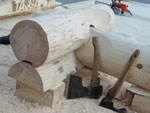 |
|
Wool insulation - ISOLENA |
Wool insulation ISOLENA - detail |
Wool insulation - detail 2 |
|
Norwegian technology - joint |
Technology Element - hole |
Technology Element - pin |

Norwegian Technology
It is characterised by the use of logs known as prisms that are processed on two sides. The surface of the interior and exterior walls of a log house built with the aid of the Norwegian technology is always flat. A typical feature of this technology is the "Norwegian joint", i.e. a wedge that is cut into the log manually with an axe (i.e. "axe technology"). This joint is unique in the way in which it allows the logs to interlock in the corners (i.e. wedge to wedge) as a result of their own weight while the house is settling and drying (even in the case of pre-dried timber). This eliminates possible deformation and unwanted rotation of the components due to intense internal tension. In order to prevent the prisms in the walls from swaying and to avoid any unevenness in the house walls, the prisms are vertically interconnected with wooden pins. Holes are drilled into the wall beams into which pins are inserted to connect the adjacent beams together. The pins are made of the same type of wood as the house. This construction technology requires a technological interruption after the assembly of house is completed to allow the structure to settle down and the wood to dry. In case of the Norwegian technology, such an interruption may last from 7 to 8 months depending on the size and the complexity of the structure. Afterwards, the dimensions of all openings are precisely measured in order to make tailor-made windows and doors.
Technology Characteristics:
| Most frequently used material: | Pine, larch |
| Diameter of logs for prisms: | 280 - 500 |
| Width of prism for log house: | 200 |
| Width of prism for smaller structure mm: | 150 |
| Maximum settling mm: | 30 - 50 |
| Maturing period/td> | 7 - 8 měsíců |
Canadian Technology
This technology is characterized by the use of round timbers as the main construction component. The trunks may be processed into construction components as soon as bark is removed. This construction method requires immense craftsmanship and precise workmanship. The typical feature of this technology is that there are no spaces between logs thanks to which the walls appear as though made of one solid block. The absence of gaps between the logs is achieved with the aid of a special marker. In this case, insulation is placed in an insulation groove leading along the whole length of the log. Since the logs retain their natural curved shape, they provide the house and its walls with a one of a kind appearance and character. The precisely (with an accuracy of one millimetre) tooled corner log joints are a perfect example of true carpentry artistry. Another unique feature of this technology is that the outer layer of the round timbers remains intact (it is removed only during timbering). This prevents the walls from freezing when temperatures drop below zero and substantially prolongs the life of the structure. The preserved outer layer contributes to the proper filtration of air in the round timber and creates a unique microclimate inside the log house, keeping the interior cold in summer and warm in winter. Moreover, the preservation of the solid outer layer (a 3-5 cm layer) makes the round timber more resistant to the effects of the surrounding environment, to mould occurrence, blueing, as well as to structural changes caused by UV radiation.
Technology Characteristics:
| Most frequently used material: | Pine, larch |
| Diameter of logs: | 280 - 500 |
| Maximum settling mm: | 70 - 100 |
| Maturing period/td> | 12 - 18 měsíců |
Wood Protection
In order to protect the individual logs, prisms and other log house components, we use natural oils and waxes, which preserve the natural appearance of wood and enhance its weatherproof properties. Pigmented glazes by Kreidezeit, which are available in a wide range of colours and shades, add a special touch to the final look of the wood, as well as the individual components. The priming (ground) coat is applied when the log house is disassembled while still at the plant. The first coat protects the individual house components during transport. It is only temporary as it vaporizes after 2 months and a new coat providing long-term protection needs to be applied. The most suitable are natural oils and waxes because they provide wood with the necessary protection. These products offer comprehensive care for the interior and exterior of the log house. As regards insulation material in the houses built by us, clients may choose products from the ISOLENA company, which manufactures thermal insulation with the use of sheep wool. Sheep wool may replace all thermal insulation materials used throughout the house. Its thermal and insulation properties match other traditional insulation materials. As a genuinely natural material, sheep wool is becoming widely used in the construction of wooden houses. Thanks to its unique protein fibre structure, sheep wool creates a more pleasant environment inside the house. And since it does not contain any artificial or cellulose fibres, there is no risk of any dust or small particles being released into the air (as in the case of glass silk). Sheep wool insulation does not increase the volume of dust in the house either during installation or subsequent use. Prior to use, wool is treated with chemicals that enhance its resistance to pests and moisture. Naturally, wool is anti allergic and helps regulate the level of humidity in the interior. We recommend ISOLENA for the insulation of our wooden houses because it is an environmentally-friendly and very pleasant material.
Wood is highly aesthetic, elegant and above all ecological. It is the healthiest and the most natural material for man.
Russian Hook Technology
This technology is characterized by the use of components that are naturally round on the outside and in the corners and flat on the inside. It is an old technique developed by carpenters from the Sokol district of the Nizhny Novgorod Region, which is well known for its tradition of manual building of log houses and wooden ships. The Russian hook technology is a technique of hooking overhanging logs together in the corner. It is a more complex method as it uses round logs with a basic plug and hewn interior walls. It is rather demanding and requires a high level of carpentry craftsmanship. The planed walls require no additional processing, which results in considerable cost savings. The Russian hook technology offers the most reliable joining of logs in the corners. A house built with the aid of this technology retains the matchless beauty of round timber while offering considerable interior comfort.
Technology Characteristics:
| Most frequently used material: | Pine, larch |
| Diameter of logs: | 280 - 500 |
| Maximum settling mm: | 60 - 90 |
| Maturing period/td> | 10 - 14 měsíců |
Larch
As the hardest European coniferous trees with a life span of up to 20 years, the Krasnoyarsk larch undoubtedly belongs among very attractive, yet still not "Oriental" woody species (Figure 3).
Green Roof Technology
 Green roofs have been known throughout the world for ages, especially in northern countries. In certain areas, they are widely used even today, often in combination with log cabins. A green roof is in fact a continual layer of soil with vegetation, which is placed on a specific base layer. The base layer separates the soil from the structure and protects it against penetrating roots and moisture. Compared to traditional roofing material, the green roof technology offers a number of advantages.
Green roofs have been known throughout the world for ages, especially in northern countries. In certain areas, they are widely used even today, often in combination with log cabins. A green roof is in fact a continual layer of soil with vegetation, which is placed on a specific base layer. The base layer separates the soil from the structure and protects it against penetrating roots and moisture. Compared to traditional roofing material, the green roof technology offers a number of advantages. The most significant advantages include:
- Improved thermal and insulating properties of the roof construction
- Improved fire resistance
- Improved noise absorption
- Prolonged hydro insulation durability
- Water retention and gradual vaporization improves the microclimate of the structure surroundings
- Reduced day and night temperature fluctuations
- Beneficial impact on the surrounding environment
 Green roofs are divided into two categories: extensive and intensive. Intensive green roofs offer the possibility of being used as an additional, grass-covered part of the garden. An intensive green roof is designed to accommodate people who may sunbathe or relax on it all day. Extensive roofs, on the other hand, are not designed to be walked on.
Green roofs are divided into two categories: extensive and intensive. Intensive green roofs offer the possibility of being used as an additional, grass-covered part of the garden. An intensive green roof is designed to accommodate people who may sunbathe or relax on it all day. Extensive roofs, on the other hand, are not designed to be walked on.Parameters
- Extensive roof:
80 – 170 kg/m2 roof construction load for 80 – 150 mm layers; various types of grass, moss and alpine plant species may be planted depending on the specific layer thickness
- Intensive roof:
300 kg/m2 and more roof construction load for layers from 250 mm (depending on the construction type and client requirements); various types of grass, smaller and larger tree and shrub species may be planted in the layer
Intensive green roofs are fitted with safety railing. The inclination of green roofs ranges from 5 to 45° or even 90° in exceptional cases. For these types of roofs, we offer irrigation systems, as well as a wide variety of grass seeds, brush and other plant species.
Log House Construction Tools
We would like to familiarize you with the tools that are used during the construction of log structures and houses. Our main specialists include carpenters and joiners.
They are mostly highly skilled and experienced in both crafts.
Below you will find examples of some of the tools used by us. They are handmade from steel by skilled blacksmiths from different parts of the world. We construct log houses with the aid of the Canadian, Norwegian, and the Russian hook technology. The country of origin of these technologies is obvious from their names. Each construction technology obviously requires the use of different tools.
|
|
|
|
|
|
|
|
|
|
|
|
VISHERA Modular Glulam Beam Technology
Another technology used by Monivet is the glued laminated (glulam) beam technology. It is a brand new technology, the main advantage of which is the absence of a technological interruption that is otherwise required for the log structure to properly settle. The technological interruption in case of a house built with the aid of the Canadian technology is 18 months. On the other hand, with the glulam beam technology, you may move into your house immediately after its completion.
The basic construction element is a glued laminated (glulam) beam, which is available in three sizes: 212x186 mm, 169x186 mm, and 126x186 mm. The laminas used for the manufacture of glulam beams are made of fir from the northern regions of Russia. The laminas are glued together using environmentally friendly Casco Adhesives produced by AkzoNobel (Sweden).
Naturally, the time necessary for the own construction is considerably shorter. For example, the speed of construction with the use of the Canadian technology is approx. 1.5 m3 per shift compared to 3.5 m3 when applying the glulam beam technology.
This means that four people may build a house with an area of 200 m2 in just 20 days!
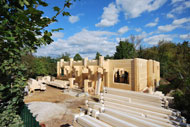 |
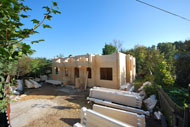 |
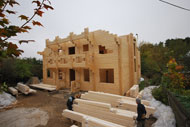 |
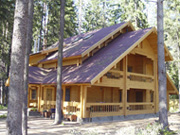 |
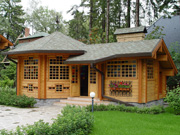 |
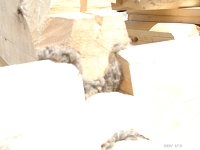
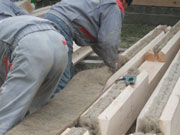
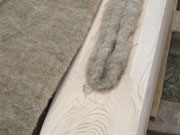
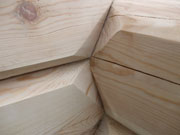
.jpg)
.jpg)
.jpg)
.jpg)
.jpg)
